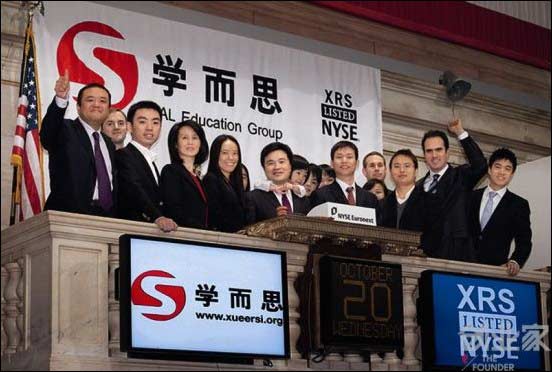
Source: TAL Education
A 2012 report by GSV Advisors said that expectations call for global education expenditures to grow by a 2012-2017 compound annual growth rate, or CAGR, of 7% from $4.5 billion in 2012 to $6.4 billion in 2017. In contrast, expectations call for the U.S. education market to grow at a slower annualized growth rate of 5% over the same period. As domestic for-profit education companies see their share prices and profits negatively affected by regulatory factors, it may be worthwhile to look at foreign education companies to capitalize on this long-term trend.
In particular, TAL Education (TAL 4.55%), the leading K-12 after-school tutoring services provider in China, stands out in comparison with peers Xueda Education (NYSE: XUE) and New Oriental Education (EDU 3.42%). Similar to TAL Education, Xueda is also a K-12 tutoring services provider in China; New Oriental Education, on the other hand, is the largest provider of private educational services in China offering a wide range of educational programs across all levels.
Industry potential and the K-12 market
Since 1990, education expenditures by Chinese families have increased by a CAGR of 29.3%, which compares to annualized growth rates of 16.6% and 13.6% for GDP and urban household income, respectively. Within the entire Chinese education spectrum, the K-12 market has been one of the fastest-growing segments and expectations call for its revenues to more than double from $27.9 billion in 2009 to $65.7 billion in 2014 according to iResearch.
More importantly, while people in China spend a higher portion of their household incomes on education than people in some other Asian countries do at 30% (the figure is 22% for Korea and 10% for Japan), note that the current K-12 penetration rate in China of 30%-35% is significantly lower than the penetration rate of 70%-90% for Korea. This implies that the Chinese K-12 market has significant growth potential.
In contrast with TAL Education, which is a pure proxy for the Chinese K-12 market, New Oriental Education is largely a provider of language training and test preparation courses that generates less than 3% of its revenues from primary and secondary education services. As a result, TAL Education is a better investment candidate for capitalizing on the growing K-12 market than its larger peer New Oriental Education.

Source: TAL Education
Premium brand and market segmentation
While the potential of the Chinese market is huge, the market is also fragmented. The top five players in the Chinese tutoring market account for 3% of the total market share, and no single one of them represents more than 1% of the total industry revenue. However, bigger players like TAL Education are well-positioned to take market share from regional players and individual tutors.
Moreover, TAL Education has differentiated itself from its peers by building a premium brand that focuses on the best students and avoids the more-competitive mass-market segment. As an illustration, TAL Education's students won a total of 27 medals at the 2013 China Mathematics and Physics Olympiads, and 328 of its students in Beijing were admitted into China's top universities Peking University and Tsinghua University.
The results speak for themselves. For the most recent 2013 fiscal year, TAL Education achieved a higher operating margin than its peers at 13.6%. In contrast, New Oriental Education and Xueda Education boasted comparatively lower margins of 12.8% and 4.2%, respectively. During the same period, TAL Education grew enrollments by 18% while it raised average selling prices by 8% at the same time. Its student retention rates are as high as 70%. This reflects strong pricing power. In addition, TAL Education's K-12 online course brand, Xueersi.com, is also the market leader in the space with 28.9% market share, which edges edging out competitors such as New Oriental Education's koolearn.com (18.3% market share).
Growth opportunities
While TAL Education is a smaller company (with $200 million in fiscal 2013 revenue) than its peers New Oriental Education (with $900 million in fiscal 2013 revenue) and Xueda Education (with $900 million in fiscal 2013 revenue) in terms of revenue, that could be a positive rather than a negative, especially with respect to future growth opportunities.
While Xueda Education boasted 408 Learning Centers across 77 cities in China as of December 2013, TAL Education had a presence in only 15 cities with 265 Learning Centers. Furthermore, TAL Education has the potential to expand its business in both newly entered and existing markets. For example, in the five cities (Zhengzhou, Taiyuan, Chongqing, Suzhou and Shenyang) which TAL Education entered in 2012, the company operates less than five Learning Centers in each of these cities and none of them are its higher margin One-on-One Centers. In its existing markets, TAL Education can still pull growth levers such as adding new learning centers, enhancing the capacity of existing centers, and increasing its range of subjects and grade levels across all cities.
Foolish final thoughts
With the U.S. for-profit education industry facing headwinds, investors are advised to look abroad for attractive investment opportunities in the global education industry. TAL Education is my top pick in the Chinese education market because it is a pure K-12 education services provider with premium positioning and it has the best growth runway among its peers.




